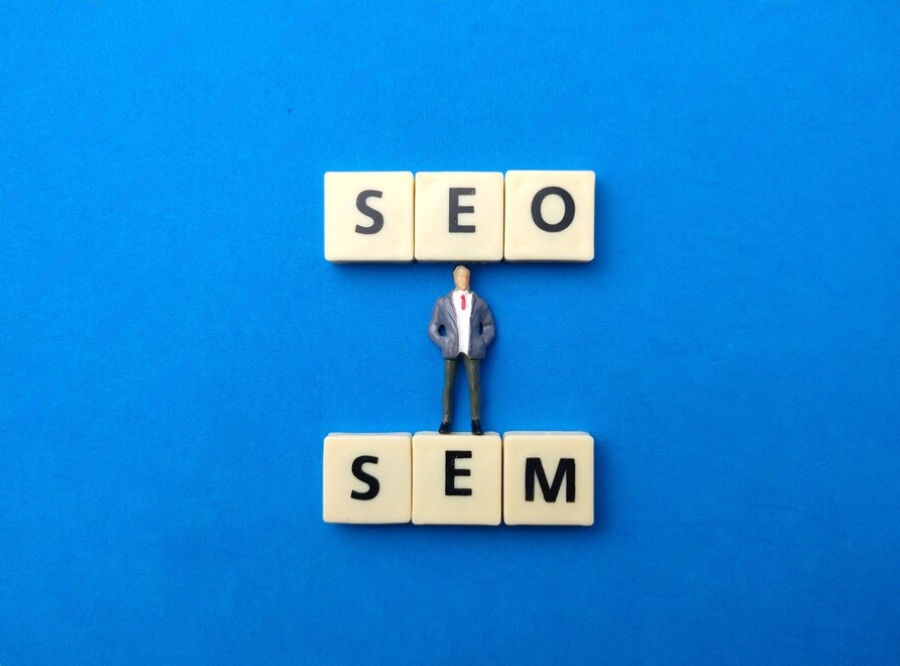

In today’s competitive digital landscape, businesses must employ effective strategies to increase their online visibility and attract potential customers. Two of the most widely used techniques in digital marketing are Search Engine Marketing (SEM) and Search Engine Optimization (SEO). Both play critical roles in driving traffic to websites, but they operate in different ways and serve distinct purposes. Understanding the key differences between SEM and SEO is crucial for marketers looking to craft successful campaigns and maximize their return on investment (ROI).
This blog will explore the concepts of SEM and SEO, their unique characteristics, the benefits and challenges of each approach, and how businesses can effectively utilize both to enhance their digital marketing efforts.
What is SEM?
Search Engine Marketing (SEM) is a form of online advertising that involves promoting websites by increasing their visibility in search engine results pages (SERPs) through paid ads. SEM encompasses a range of paid strategies, but it is most commonly associated with Pay-Per-Click (PPC) advertising, where advertisers bid on specific keywords and pay a fee each time their ad is clicked.
Key Components of SEM
SEM campaigns generally consist of the following key components:
- Keyword Research: Identifying relevant keywords that potential customers are likely to search for is the foundation of any SEM campaign. Marketers bid on these keywords to ensure their ads appear when users search for them.
- Ad Creation: Crafting compelling ad copy that resonates with the target audience is critical for success in SEM. Ads typically include a headline, description, and a call-to-action, all designed to entice users to click.
- Bidding Strategy: SEM operates on a bidding system, where advertisers compete for ad placements based on how much they are willing to pay per click (CPC) or per thousand impressions (CPM). Higher bids generally lead to better ad placement, though ad quality also plays a role.
- Ad Placement: Once the bidding process is complete, ads are displayed on SERPs in a prominent position, often above or below the organic search results. These ads are labeled as “Sponsored” or “Ad” to differentiate them from organic listings.
- Campaign Monitoring and Optimization: SEM campaigns require ongoing monitoring to ensure optimal performance. Marketers analyze metrics such as click-through rates (CTR), conversion rates, and cost-per-click (CPC) to fine-tune their campaigns for maximum effectiveness.
Benefits of SEM
- Immediate Results: One of the biggest advantages of SEM is that it can produce immediate results. Unlike SEO, which may take time to build organic rankings, SEM allows businesses to appear at the top of SERPs as soon as their ads are approved.
- Targeted Audience: SEM enables precise targeting based on keywords, demographics, location, and other factors. This ensures that ads are shown to the most relevant audience, increasing the likelihood of conversions.
- Measurable ROI: SEM provides detailed data on campaign performance, allowing marketers to measure ROI accurately. Metrics such as clicks, impressions, and conversions can be tracked in real-time.
Challenges of SEM
- Cost: SEM can be expensive, especially for highly competitive keywords. Businesses must carefully manage their budgets to avoid overspending on paid ads.
- Short-Term Strategy: SEM primarily delivers short-term results. Once the ad budget is depleted, the traffic generated by the campaign may cease, requiring continuous investment to maintain visibility.
What is SEO?
Search Engine Optimization (SEO) is the process of optimizing a website to improve its organic rankings in search engine results pages. Unlike SEM, which relies on paid ads, SEO focuses on enhancing a website’s content, structure, and authority to increase its visibility in unpaid (organic) search results.
Key Components of SEO
SEO involves several key components that work together to improve a website’s search engine rankings:
- On-Page SEO: On-page SEO refers to optimizing individual web pages to improve their search engine rankings. This includes optimizing content for relevant keywords, improving meta tags (title tags, meta descriptions), and ensuring that the website is mobile-friendly and fast-loading.
- Off-Page SEO: Off-page SEO focuses on building the website’s authority through external factors, such as backlinks from reputable sites. The more high-quality backlinks a website has, the more likely it is to rank higher in search engine results.
- Technical SEO: Technical SEO involves optimizing the backend of a website to ensure that search engines can crawl and index it effectively. This includes improving site speed, fixing broken links, implementing structured data, and ensuring a secure HTTPS connection.
- Content Creation: High-quality, relevant content is the cornerstone of SEO. Creating valuable blog posts, articles, and other forms of content helps attract organic traffic and improves a website’s chances of ranking well for relevant keywords.
- Keyword Research: Just like SEM, keyword research is essential for SEO. However, instead of bidding on keywords, SEO involves optimizing content around these keywords to rank organically.
Benefits of SEO
- Cost-Effective: Unlike SEM, which requires ongoing payments for ads, SEO is a long-term investment. Once a website achieves strong organic rankings, it can continue to attract traffic without incurring additional costs.
- Long-Term Results: SEO is a long-term strategy that can provide sustainable results over time. Websites that rank well organically can continue to drive traffic even without continuous optimization efforts.
- Credibility and Trust: Organic search results are often perceived as more credible and trustworthy than paid ads. Users are more likely to click on organic listings, leading to higher engagement and conversions.
Challenges of SEO
- Time-Consuming: SEO requires patience and consistency. It can take months to see significant improvements in organic rankings, and ongoing optimization is necessary to maintain and improve these rankings.
- Algorithm Changes: Search engines frequently update their algorithms, which can impact a website’s rankings. Staying up-to-date with the latest SEO best practices and adjusting strategies accordingly is essential to maintaining visibility.
- High Competition: Achieving top rankings in competitive industries can be challenging, as many businesses are vying for the same keywords. Consistent effort and expertise are required to outrank competitors.
Key Differences Between SEM and SEO
While SEM and SEO share the common goal of increasing a website’s visibility on search engines, they differ in several key aspects:
1. Paid vs. Organic
The most fundamental difference between SEM and SEO is that SEM relies on paid ads, while SEO focuses on organic (unpaid) rankings. SEM involves paying for ad placements on search engines, whereas SEO aims to improve a website’s organic rankings through optimization.
2. Immediate Results vs. Long-Term Strategy
SEM offers immediate results, as paid ads can appear at the top of search engine results pages as soon as a campaign is launched. SEO, on the other hand, is a long-term strategy that requires time and effort to achieve and maintain organic rankings.
3. Cost Structure
SEM operates on a pay-per-click (PPC) or pay-per-impression (CPM) model, where businesses pay for each click or impression their ad receives. In contrast, SEO does not involve direct payments to search engines. Instead, the investment is in the time, resources, and expertise required to optimize the website.
4. Ad Placement vs. Organic Listings
SEM ads are typically placed at the top or bottom of SERPs, clearly labeled as “Sponsored” or “Ad.” These ads stand out from organic listings, which appear based on the website’s relevance and authority in relation to the search query.
5. Click-Through Rates (CTR) and User Perception
Organic listings often receive higher click-through rates (CTR) than paid ads because users tend to trust organic results more. SEM ads can attract clicks quickly, but users may skip them in favor of organic listings that they perceive as more credible.
6. Sustainability
SEM is a short-term solution that requires ongoing investment to maintain visibility. Once the ad budget runs out, the traffic generated by the campaign stops. SEO, however, is a more sustainable approach. Once a website achieves strong organic rankings, it can continue to attract traffic without ongoing payments to search engines.
How to Integrate SEM and SEO for Maximum Impact
While SEM and SEO are different strategies, they are not mutually exclusive. In fact, combining both approaches can lead to a more comprehensive and effective digital marketing strategy. Here’s how businesses can integrate SEM and SEO for maximum impact:
1. Use SEM for Immediate Visibility While Building SEO
Businesses can use SEM to gain immediate visibility and traffic while working on their long-term SEO strategy. Paid ads can generate clicks and conversions quickly, while SEO efforts gradually improve organic rankings over time.
2. Leverage Keyword Data from SEM for SEO
SEM campaigns provide valuable data on which keywords drive the most traffic and conversions. This data can be used to inform SEO strategies, helping businesses optimize their content around high-performing keywords.
3. Optimize Landing Pages for Both SEM and SEO
Landing pages used in SEM campaigns should also be optimized for SEO. By ensuring that these pages are relevant, well-structured, and keyword-rich, businesses can increase their chances of ranking organically while also benefiting from paid traffic.
4. Monitor and Adjust Campaigns Based on Performance
Both SEM and SEO require ongoing monitoring and adjustments based on performance data. Businesses should regularly analyze their SEM and SEO campaigns to identify areas for improvement and optimize their strategies accordingly.
Conclusion
Understanding the key differences between SEM and SEO is essential for businesses looking to improve their online visibility and drive traffic to their websites. While SEM offers immediate results through paid ads, SEO provides a more sustainable, long-term approach to organic rankings. By integrating both strategies, businesses can achieve a well-rounded digital marketing strategy that maximizes their reach and impact.
Whether a business prioritizes SEM, SEO, or a combination of both depends on its goals, budget, and timeline. However, by recognizing the strengths and limitations of each approach, marketers can make informed decisions that lead to successful outcomes.
